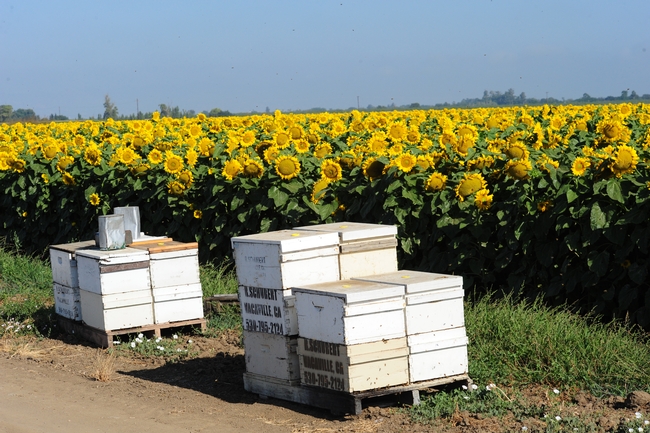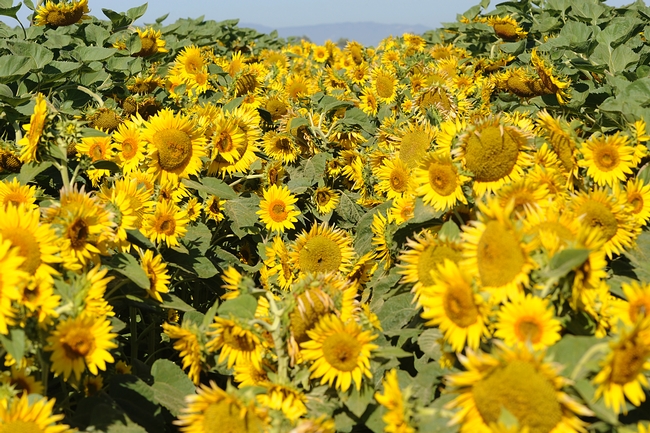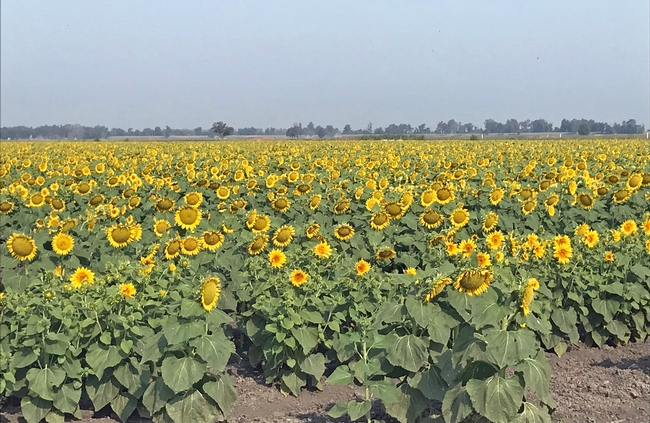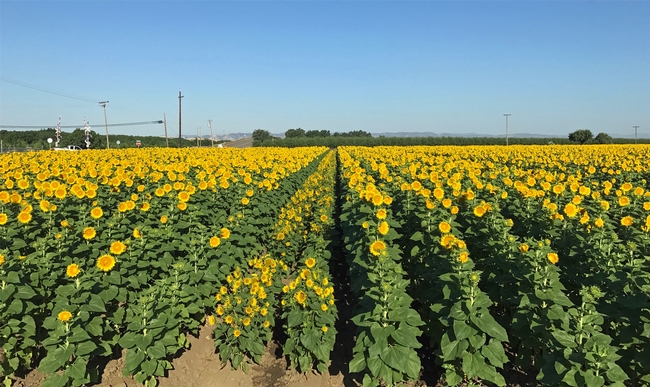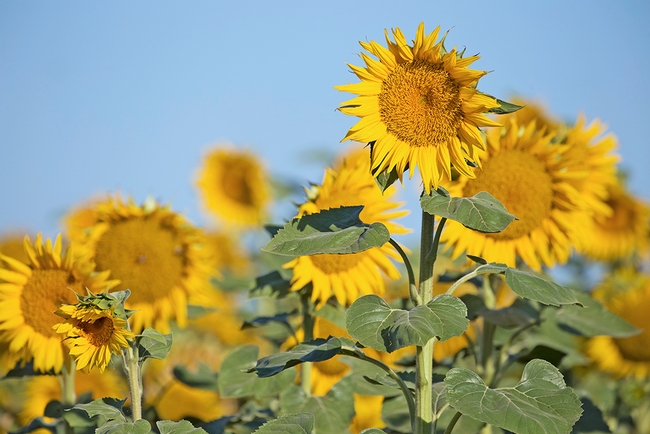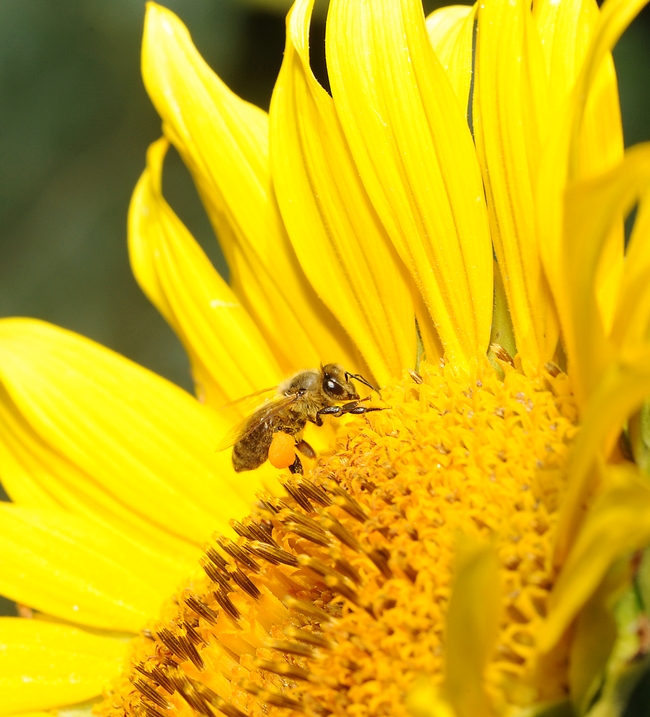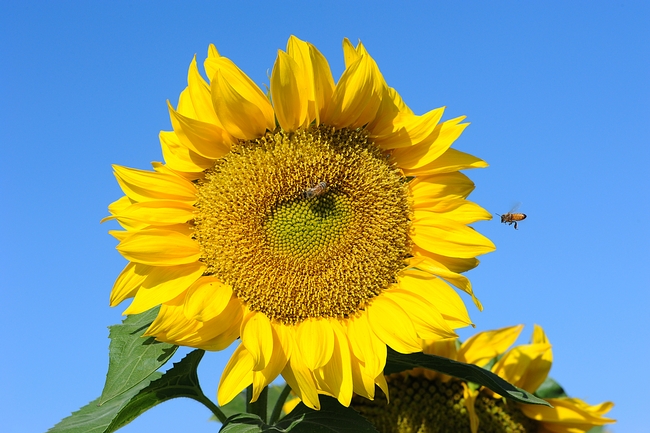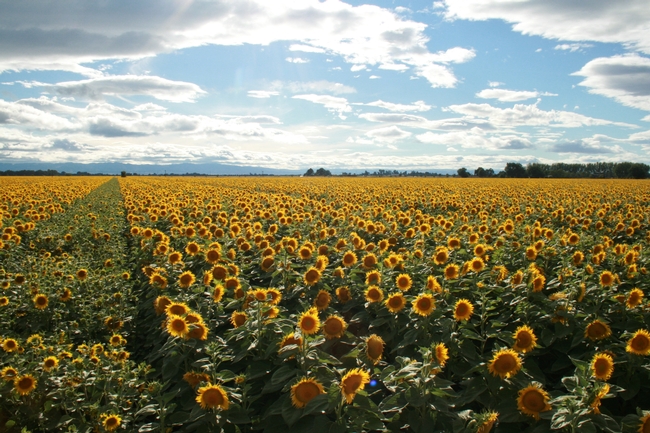Posts Tagged: sunflowers
New UC ANR cost study for growing hybrid sunflower seeds helps farmers estimate costs
A new study on the costs and returns of producing hybrid sunflower seed in the Sacramento Valley has been released by the UC Agriculture and Natural Resources' Agricultural Issues Center for farmers who are considering growing hybrid sunflower seeds.
“Although the acreage is relatively small – about 50,000 acres in the Sacramento Valley – hybrid sunflower seed is an important crop because California growers produce the seed for planting stock, destined to be planted in many areas around the world for oilseed and confectionary snack food markets,” said Sarah Light, UC Cooperative Extension agronomy advisor and co-author of the cost study.
Authors Rachael Long, Mariano Galla and Light received input and reviews from fellow UC Cooperative Extension farm advisors and agricultural industry cooperators for the study, which is based on a typical farm in the Sacramento Valley producing field and orchard crops.
“One thing new in our cost study is that it's based on a crop that is irrigated with subsurface drip as opposed to flood,” Long said.
The study estimates the cost of hybrid sunflower seed production on 200 acres as part of a row crop rotation, using subsurface drip irrigation. The subsurface drip irrigation tape is replaced every seven years. Annually, 15 percent, or 30 acres, of the subsurface drip tape is replaced.
To avoid cross-pollination with other sunflower varieties, hybrid sunflower seed production requires at least a 1.25-mile field isolation or different planting times. In this study, male sunflower seed is planted in three rows on a single 5-foot bed and female seed is planted in two rows on three 5-foot beds. The field ratio is 25 percent male parent lines to 75 percent female parent lines. With two hives per acre, honey bees are used to cross-pollinate between the parent lines. The male lines are destroyed after pollination to prevent seed contamination of the female lines.
The authors used current production practices to identify costs for the sunflower crop, including material inputs and cash and non-cash overhead. The study includes tables that show profits over a range of prices and net yields, monthly cash costs, costs and returns per acre, hourly equipment costs, and the whole farm annual equipment, investment and business overhead costs.
The new study, “Sample Costs to Produce Sunflowers for Hybrid Seed in the Sacramento Valley – 2018,” can be downloaded for free from the UC Davis Department of Agricultural and Resource Economics website at http://coststudies.ucdavis.edu.
Sample cost of production studies for many other commodities are also available at the website.
For additional information or an explanation of the calculations used in the studies, contact the Agricultural Issues Center at (530) 752-4651 or UC Cooperative Extension advisors Rachael Long at rflong@ucanr.edu, Sarah Light at selight@ucanr.edu, or Mariano Galla at mfgalla@ucanr.edu.
Radiant daisy-like sunflowers produce a valuable crop with little water
Sweeping acres of striking golden flowers may soon grace California's desert southwest. UC Cooperative Extension irrigation specialist Khaled Bali believes sunflowers may be an ideal crop for the state's most punishing agricultural region.
California produces more than 90 percent of the country's hybrid sunflower planting seed, which is shipped around the nation and world. The seed is used to grow sunflower seeds for a healthy snack or salad topper, and for seeds that are expressed into sunflower oil, valued for its clean taste and polyunsaturated fat.
Most California seed is produced on about 50,000 acres in the Sacramento Valley. But the plant's low water use and early maturity hold promise for production in Southern California's low desert.
Bali's research began two years ago with 1,800 plots of sunflowers, nearly 300 different genotypes, at the UC Desert Research and Extension Center in Holtville. All plants were well-watered for four weeks before drought treatment started. In 2016, the trial plots were irrigated at 60 percent of the area's ETo (the full amount of water used by well-irrigated, mowed grass in that environment), and at 100 percent.
“Sunflower is a California native species grown as a hybrid seed crop,” Bali said. “With limited water, we wanted to look at varieties that tolerate drought and stress.”
That year, Bali found significant variation in yield across the varieties, but no difference between plots that received 60 percent of ETo and 100 percent
“I've been doing deficit irrigation for a long time,” Bali said. “I never expected that.”
For the 2017 season, the 60 percent ETo plots were dropped to 10 percent to better understand the implications of severe drought on the sunflower cultivars.
“The emphasis in 2017 was to intensify our drought treatment, giving less water earlier and to quantify the genotypes' drought avoidance strategy by digging up roots and using computer image analysis to determine root traits,” Bali said.
Bali attributes the sunflower crop's low water needs to its deep tap root and crop production timing. Sunflower in the low desert may be planted from January to February, and harvested in May and June.
“Sunflower water needs are relatively low since they are harvested before the hottest part of the summer,” Bali said.
His research is continuing in 2018.
A new UC publication, Sunflower Hybrid Seed Production in California, is now under review and is expected to be available to producers in fall 2018. Written by UC Cooperative Extension advisor Rachael Long and colleagues, including Bali, the publication outlines crop production standards, land preparation, fertilization, pest management, harvesting and more.
Long said sunflowers are favored for crop rotations because they help in long-term management of weeds and diseases, the plants add biomass to the soil after harvest, and they are a profitable specialty field crop.
Read more about California sunflowers in a Green Blog post by Rachael Long, Sunflower seeds are boosting California's ag economy.
Sunflower seeds are boosting California’s ag economy
Sunflower seeds are a healthy snack, a salad garnish, and a baseball dugout icon. But how much do you know about the state’s hybrid seed production that results in the global planting and growing of oil and confectionary-type sunflower seeds?
Do you know that the Sacramento Valley produces about 25 percent of the world’s hybrid planting sunflower seeds? We grow some 47,000 acres of this crop, valued at about $70 million (2012 County Crop Reports).
Even better news is that the hybrid sunflower seed production industry is growing, sparked by the demand for our high quality seed and the increased interest in sunflower oil worldwide. In 2007, for example, the value of California’s sunflower seed crop totaled $22 million on 27,000 acres. Fast forward to today and we see a 70 percent increase in acreage and more than a three-fold increase in value. Additionally, the industry reports millions of dollars in seed sales to markets around the world including the Midwestern states as well as the four largest producers of sunflower oil: Ukraine, Russia, European Union, and Argentina.
The sunflower (Helianthus annuus) is native to North America; the Native American Indians prized it as an important, high-energy food source. Indeed, sunflower oil is a healthy choice; it is light in taste, supplies more vitamin E than any other vegetable oil, and delivers low levels of saturated fat. Sunflower oil is also stable at high cooking temperatures, rendering it favorable to the food processing industry.
Production of hybrid sunflower seeds involves planting male and female (male sterile) lines in the same fields, usually alternating with six rows of females and two rows of males. Males generally possess multiple flowers on a stock, compared to the single composite female flower. Honey bees, usually two colonies per acre, move the pollen from the male to female lines. Native solitary bees (especially sunflower bees) are also important in sunflower seed production, not only because of their pollination but because their presence increases honey bee activity, causing greater dispersement between male and female lines.
After pollination, when the seeds are set, growers remove the male rows to prevent contamination with female rows. After the sunflower stocks naturally dry down, the hybrid planting seed is harvested with yields averaging 1,400 pounds per acre and 40-45 percent percent oil content, depending on the variety.
Compared to open pollinated varieties, hybrid planting seed from controlled crosses of male and female lines result in higher yields and oil content. The plants also display better disease resistance, a high degree of self-compatibility (reducing the need for bee cross-pollination), and more uniformity in height and moisture content at maturity, which facilitates harvest.
It’s crucial to maintain field isolation between different hybrid sunflower varieties so that the seed produced remains pure to the desired cross. As a result, growers plant different sunflower seed varieties at least 1-1/4 miles apart or they separate fields in time so that they bloom at different times in the season, thus preventing pollen drift. volunteer sunflowers from the previous year, wild sunflowers, and sunflower varieties blooming in backyard gardens pose risks to hybrid sunflower seed production. Roguing prior to bloom is important when nearby production fields are blooming.
Do you know that sunflower seed production has few pest or disease problems? Sunflower head moth, a native caterpillar pest, can attack the seed heads as well as occasional flocks of birds (starlings, blackbirds, and finches) triggering yield and quality losses.
As the result of industry and research efforts, along with our near perfect weather for seed production with hot, dry summers and cool nights, the Sacramento Valley is known throughout the world as a premier location for sunflower breeding, variety development, and seed production.
In the summertime, the brilliant golden colors turn fields in the Sacramento Valley into Vincent Van Gogh-like paintings. Sunflowers are also fun to watch because in the bud stage they track the movement of the sun across the horizon. Once the flower opens it faces east toward the morning sun, which may help prevent the sun-scalding of seeds.
So, whether you like to cook with sunflower oil, snack on sunflower seeds, use them as a salad garnish, or watch your favorite baseball players crack them between innings, sunflowers pack a major economic agricultural wallop that begins right here in the Sacramento Valley. Who knew? Now you do.
